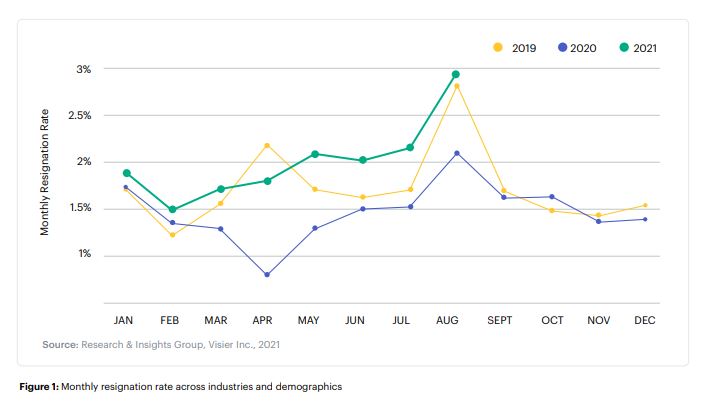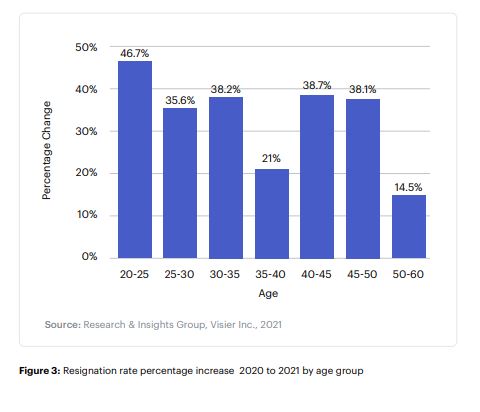Visier: Employers must use data to tackle the ‘Great Resignation’
Otherwise they risk losing their young employees, as well as older experienced talent.
Why You Should Care
People are leaving the workplace in droves.
Interestingly, Visier's latest report found that it is not only younger employees quitting their jobs, but also older, more experienced talent.
How can proper use of data help with talent retention?
The ‘Great Resignation’ is real, and it is upon us. But what differentiates this resignation wave to previous ones?
According to Visier’s ‘Stop the Exit’ report, which relies on its Community People database of standardized and anonymized data from 11 million employee records from 11,000 companies, the first thing to note is that scale and volume of the wave is enormous.
The annualized resignation rate of January to August 2021 was 25%, compared to 22% for 2019 and 18% for 2020.

The second noteworthy element is that in addition to the usual trend of younger employees with shorter tenures at companies leaving to further the career, the talent drain in 2021 includes a large proportion of “tenured, experienced professionals”. The ‘Great Resignation’ is also affecting not just those at the start of their careers, but those in the middle as well.
The resignation rate of employees with ten to fifteen years of tenure is 54.6% higher than in 2020; this rises to 56.8% for those with five-to-ten-year tenure.
This means that companies are losing their most experienced, and often most valuable, employees in droves. This is particularly concerning since the cost of replacing an employee is twice the salary, so the more experienced the talent who are leaving, the most costly they are to replace.
Further to this, Visier identified a more than 38% resignation rate rise for those aged between 30 and 35, 40 and 45 and 45 and 50 in 2021. This shows that this resignation wave is wave employers revaluating their approach to their employer and work in general in 2021.

The final concerning finding of Visier’s report is that women are resigning at a higher rate than men. While 2021 has seen a significant increase in the resignation rate for both genders (55.4% growth for women and 47.2% for men), the growth rate for women was 17% higher than for men.
This is a major concern for companies trying to be more gender diverse and has a wider impact on the global post-pandemic economic recovery.
How must companies tackle this?
Visier is very clear that employers need to focus in on the needs of their particular employee population – what works for one company won’t necessarily work for another.
Therefore, Visier urgently calls for “a data-driven approach to assess resignation risks, to identify and act on mitigation opportunities, and to monitor progress.”
To achieve this, Visier suggests that employers focus on collecting the right data and then using that to monitor their talent retention success.
They also need to focus on the most important populations to the business and really hone in on their concerns, and address them – whether it is around career development, burnout or a desire for particular benefits.
Finally, Visier recommends that companies personalize the response to those populations and ensure all policies are enacted by both HR and individual managers.
Sign up to the UNLEASH Newsletter
Get the Editor’s picks of the week delivered straight to your inbox!

Chief Reporter
Allie is an award-winning business journalist and can be reached at alexandra@unleash.ai.
